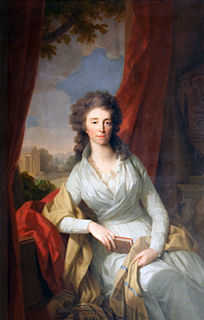 W
WJohann Christian Claudius Devaranne was one of the leaders of the Russian Truncheon Insurgency directed against Napoleon I of France's military occupation of Solingen in Germany's North Rhine-Westphalia. Up through the time of his involvement with the insurgency, Devaranne operated an inn and hardware store in Solingen's Wald district.
 W
WSimon Edler von Lämel was an Austrian-Jewish merchant who devoted his life to bettering the lives of his fellow Jews.
 W
WPrincess and Landgravine Louise of Hesse-Darmstadt was a German princess. She was the daughter of Louis IX, Landgrave of Hesse-Darmstadt. On 3 October 1775 she married duke Charles Augustus of Saxe-Weimar-Eisenach and as such a member of the court sphere of Weimar Classicism. She was held to be serious and introverted but also compassionate and sympathetic, in the aftermath of the Battle of Jena which guaranteed her part in the later "myth of Weimar" ("Weimarmythos").
 W
WDuchess Louise of Mecklenburg-Strelitz was Queen of Prussia and the wife of King Frederick William III. The couple's happy, though short-lived, marriage produced nine children, including the future monarchs Frederick William IV of Prussia and Wilhelm I, German Emperor.
 W
WJohann Philipp Palm or Johannes Philipp Palm was a German bookseller and a strong anti-French agitator and freedom fighter executed during the Napoleonic Wars at Napoleon's orders.
 W
WJohann Christian Reil was a German physician, physiologist, anatomist, and psychiatrist. He coined the term psychiatry – Psychiatrie in German – in 1808.
 W
WJohanna Stegen, was a German heroine of the Napoleonic Wars.
 W
WJohann Michael Voltz was a German painter, graphic artist and political cartoonist.